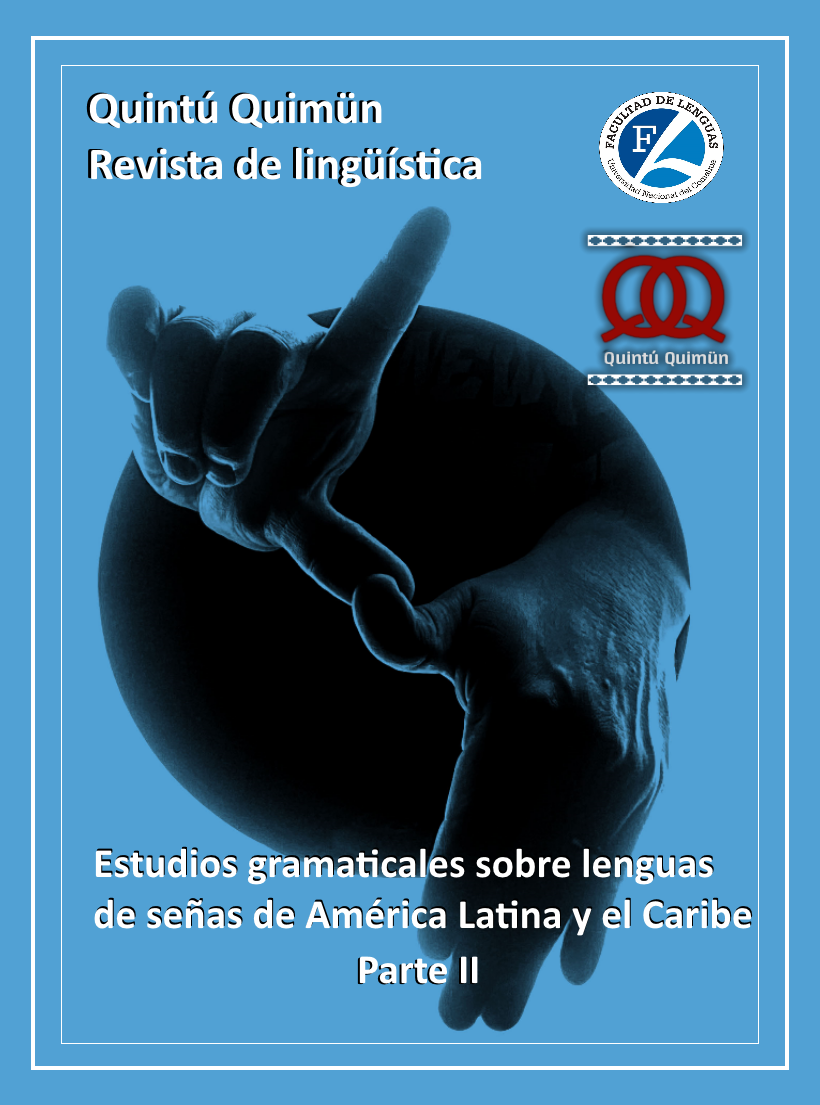Nominal reduplication as plural marking in Argentine Sign Language: a descriptive approach
Main Article Content
Abstract
The present research aims to describe nominal reduplication in Argentine Sign Language (LSA), specifically as a plural marking mechanism. For this purpose, we use Pfau and Steinbach´s (2005) classification of nouns. Depending on the morpho-phonology of the signs, they divide nouns into four categories: lateral articulation nouns, sagittal articulation nouns, body-anchored nouns, and complex movement nouns. We worked in a discussion group with Deaf people and interpreters on real constructions taken mostly from videos in LSA. Our study shows that, for LSA, nouns with lateral articulation and those with sagittal articulation admit reduplication with sidewards movement (the latter with differences depending on whether the sign is one-handed or two-handed); body-anchored nouns admit, some of them, simple reduplication nouns, and others none at all (0-marking); and nouns with complex movement do not admit reduplication. Likewise, we observe that, in cases of 0-marking, the plural morpheme can be expressed together with another sign, which can be of different categories. With this, we differ from the proposal of Muñoz Pérez, Boria and Galvez (2020), for whom only lateral articulated nouns admit reduplication, and in all other cases the plural information is externalized by means of a classifier.
Downloads
Article Details

This work is licensed under a Creative Commons Attribution-NonCommercial-ShareAlike 4.0 International License.
Los autores de los artículos publicados conservan los derechos de copyright.
Licencia de uso:

Creative Commons Atribución-NoComercial-CompartirIgual 4.0 Internacional.
References
Benedicto, Elena y Brentari, Diane (2007). ¿Qué hay, qué se mueve, quién mueve qué (y a dónde): los clasificadores de la lengua de señas estadounidense (ASL). Cvejanov, S. (dir.) Lenguas de señas: estudios de lingüística teórica y aplicada, Neuquén: EDUCO. Editorial de la Universidad Nacional del Comahue, 73-93.
Boven, Cindy van (2020). Fill the gap: A novel test to elicit nominal plurals in Sign Language of the Netherlands. FEAST 3: 56-67. https://doi.org/10.31009/FEAST.i3.05
Cvejanov, Sandra. (2002) Incorporación en verbos de movimiento de la lengua de señas argentina. Tesis de Maestría inédita. Universidad Nacional del Comahue.
Garau Cordovés, Marianela y Fernández Hernandez, Eric (2018). La reduplicación de las señas: un recurso gramatical importante en la investigación y en la enseñanza de la Lengua de Señas Cubana (LSC). Traçôs de Linguagem, v. N° 2, p. 61-70.
Herbert, Marjorie. (2012). Pluralization in German Sign Language. Recuperado a partir de https://www.swarthmore.edu/sites/default/files/assets/documents/linguistics/2012_Herbert.pdf el 25 de septiembre de 2020.
Inkelas, Sharon y Downing, Laura (2015). What is Reduplication? Typology and Analysis Part 1/2: The Typology of Reduplication. Language and Linguistics Compass 9/12 (2015), 502-515.
Kimmelman, Vadim (2018) Reduplication and repetition in Russian Sign Language. En R. Finkbeiner y U. Freywald (eds.), Exact Repetition in Grammar and Discourse. Berlin, Boston: De Gruyter Mouton, 91-109.
Martínez, Rocío, Druetta, María Rosa y Lemmo Pablo (2017). Historización y análisis de disputas ideológicas en torno al reconocimiento legal de la Lengua de Señas Argentina. En Castro Zambrano, R. y Faye Pedrosa, C. E. (comp.) Comunidades Sordas en América Latina. Florianópolis: SC: Editora Bookess, 259-278.
Massone, María Ignacia y Martinez, Rocío (2012) Clasificadores. Curso de Lengua de Señas Argentina. Parte IIIb. Disponible en www.cultura-sorda.eu.
Massone, María Ignacia. (1993). El número y el género en la Lengua de Señas Argentina. Signo y Seña N° 2.
Muñoz Pérez, Carlos; Boria, Yanina y Galvez, Carolina. (2020). Plurales nominales en LSA: el rol de los clasificadores. ELBA IV’s Workshop, febrero 2020.
Pfau, Roland y Markus Steinbach. (2005). Plural Formation in German Sign Language: Constraints and Strategies. Versión previa a su publicación en H. Leuninger y D. Happ (eds.). Gebärdensprachen: Struktur, Erwerb, Verwendung. Linguistische Berichte Sonderheft 13. Hamburg: Helmut Buske Verlag.
Quer et al. (ed.) (2017). SingGram Blueprint. A Guide to Sign Language Grammar Writing. Publicado por W. de Gruyter GmbH, Berlin/Boston. Disponible en www.degruyter.com.
Zwitserlood, Inge. y Nijhof, Sibylla (1999). Pluralization in Sign Language of the Netherlands (NGT)”. En: J. Don y T. Sanders (eds.), OTS Yearbook 1998-1999. Utrecht: UiL OTS, 58–78. Disponible en: https://www.researchgate.net/publication/46597241_Pluralization_in_Sign_Language_of_the_Netherlands_NGT
